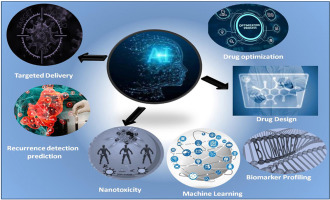
### AI System SEQUOIA Forecasts Cancer Gene Activity from Microscopy Images: A Possible Game-Changer
Stanford Medicine researchers have introduced a groundbreaking artificial intelligence (AI) tool named **SEQUOIA**, capable of predicting genetic activity in tumor cells through the analysis of standard microscopy images. This innovation has the potential to replace traditional genetic tests, which are typically costly and require weeks to process. SEQUOIA promises to deliver fast and precise information, significantly enhancing the speed of cancer treatment decision-making and lowering healthcare expenses.
The findings, featured in **Nature Communications** on **November 14, 2024**, highlight AI’s transformative impact on cancer diagnosis and prognosis.
### From Images to Gene Signatures
“**This type of software could be utilized to swiftly pinpoint gene signatures in patients’ tumors, accelerating clinical decision-making and saving the healthcare system substantial amounts of money**,” remarks **Olivier Gevaert, PhD**, a professor of biomedical data science and the lead author of the study.
The AI system was trained on an extensive dataset of **7,584 cancer biopsies** covering **16 distinct cancer types**. For each biopsy, researchers had both standard microscopy images (stained with **hematoxylin and eosin**) and detailed genetic data indicating which genes were active in the tumor cells. By examining these significant correlations, SEQUOIA learned to predict extensive patterns of gene activity, referred to as **gene signatures** — clusters of genes that operate in a coordinated fashion in tumor cells.
### A Robust Predictive Tool
The predictions from SEQUOIA were not only prompt but also precise. The AI system excelled at recognizing gene signatures that oncologists use to inform personalized treatment strategies. Notably, for certain cancer types, SEQUOIA’s predictions exhibited **over 80% correlation** with actual genetic data, indicating that AI could be a viable alternative to some cancer genomics tests in the foreseeable future.
One of the most exceptional features of SEQUOIA’s accuracy was illustrated in a comparison with **FDA-approved breast cancer tests**. These tests employ comprehensive genetic analyses to assess the risk of cancer recurrence. SEQUOIA successfully matched the capabilities of these tests in identifying high-risk breast cancer patients by solely analyzing biopsy images.
### Future Clinical Applications
While SEQUOIA is not yet ready for clinical use and requires **FDA approval**, its potential applications are immense. The AI system is set to transform cancer diagnostics by providing real-time insights. Instead of sending a biopsy for genetic testing that takes weeks, clinicians could utilize SEQUOIA to extract tumor genetic information from a biopsy during a routine procedure, enhancing treatment planning.
By presenting a quicker, more affordable alternative to genetic sequencing technologies — which can frequently amount to **thousands of dollars** — SEQUOIA could emerge as a crucial asset in future oncological care. Its capacity to swiftly identify actionable genetic data from readily available tumor tissue could alleviate the financial burden on patients and ensure that clinical timelines, where rapidity is essential, are met.
### Glossary
– **RNA sequencing:** The method of identifying which genes are active in cells at a particular time.
– **Gene signatures:** Groups of genes that consistently function together, providing important insights into tumor dynamics and potential therapeutic avenues.
– **Transcriptome:** The total set of genes being actively utilized by a cell at a given moment.
– **Biopsy:** A tissue sample taken from the body for thorough medical examination.
– **Hematoxylin and eosin staining:** A common technique for preparing tissue samples for microscopy, enhancing the contrast of cellular structures.
### Test Your Knowledge
1. How many cancer types was SEQUOIA trained on?
The AI system was trained using 7,584 biopsies from 16 different types of cancer.
2. What accuracy level did SEQUOIA achieve for some cancer types?
For certain cancer types, SEQUOIA’s predictions demonstrated over 80% correlation with actual gene activity data.
3. What type of cancer was used to validate SEQUOIA’s clinical potential?
Breast cancer, comparing SEQUOIA’s predictions to FDA-approved commercial breast cancer genomic tests.
4. What major advantage could SEQUOIA offer over current methods?
It could provide immediate genetic insights from biopsy images, replacing tests that take weeks and cost thousands of dollars.
—
SEQUOIA may signify one of the most substantial advancements in personalized cancer treatment, equipping healthcare providers with the means to create tailored treatment strategies for patients in record time. With the ongoing evolution of AI in healthcare, SEQUOIA embodies the exciting potential for the future.